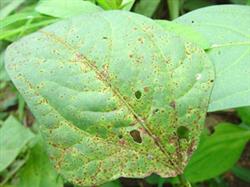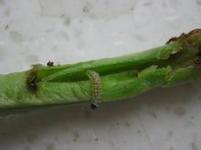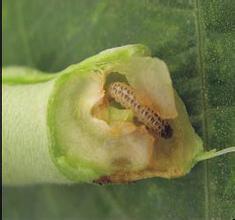How to control bean disease?

Bean diseases bean rust, bean blight, bean Fusarium wilt, bean coal mildew, bean virus disease and so on. The main results are as follows: 1. The main symptoms of bean rust: the disease mainly harms leaves and seriously damages petioles and pods. The pathogen is basidiomycetes subphylum and unicellular rust. In the early stage of the disease, there are dots of chlorotic yellow and white spots under the leaves, and the spots gradually increase until the whole leaf is covered. A slightly raised yellowish-brown spot is formed on the back of the disease spot, and the reddish-brown powder is scattered after the epidermis is ruptured. The leaves are withered and yellow, the plants are short, the pods are few and small, the growth period is shortened, and finally wither and die. Bean can be infected with bacteria throughout the growing period, and the resistance is weakened, the susceptibility is enhanced, and the source of infection is reduced during the period from the beginning of flowering to fruiting. Prevention and control methods: comprehensive control measures based on strengthening the management of soil fertilizer and water, supplemented by timely spraying. Clean the countryside. After harvest, the diseased and residual bodies in the field should be removed and burned centrally. The former crop is selected as the field of Gramineae, and the previous crop is not selected as the field of legume or peanut. Disease-resistant varieties such as Yuexia 2, Tiexianqingjiao and Suifeng 8 were selected. Timely application of medicine in the early stage of the disease. The medicament can be 50% sulfur suspension 150x, or 75% methyl topiramate wettable powder 1000 times, or 50% carbendazim wettable powder 800Mel 1000 times, or 20% carbendazim EC 800Mel 1000 times. Spray every 8 Murray every 10 days, and spray 2 Murray 3 times in a row. 2. Symptoms of bean blight: it mainly harms stems, leaves and pods, mostly in or near stem nodes, especially near the ground. The disease part was water-stained at the beginning, then the wet rot constricted around the stem, and the leaf vines above the disease part withered and died. When the humidity is high, the cortex decays and the surface produces white mold. The leaves showed dark green water stains at the beginning of the disease, and then enlarged into round light brown spots with white mildew on the surface. The disease department of the pod is also mildew and rotten. Control measures: select disease-resistant varieties. Carry out crop rotation. Select sandy loam with good drainage, adopt high border and deep ditch, reasonably close planting, make it ventilated and transparent, and pay attention to timely drainage after rain. Drug prevention and treatment, timely spray protection in the early stage of the disease, you can choose 58% Redomir manganese zinc soluble powder 500 murals 800 times, or 64% poison alum wettable powder 500 times, or 72.2% Prik water agent 800 times, can be sprayed once every 7 ml for 10 days, 2 Mel 3 times in a row. 3. When the bean Fusarium wilt plant occurs, it starts from the lower leaves. Irregular waterlogged disease spots appeared at the edge of the leaf, especially at the tip of the leaf, then the leaf yellowed and died, and gradually developed to the upper leaf, and finally the whole plant wilted and died. The cortex of the root stem of the diseased plant often cracked, the vascular bundle tissue turned brown, and the pink mildew layer appeared on the surface of the diseased part when the humidity was high. Control measures: it is best to rotate with Gramineae crops and apply lime to improve soil to reduce the occurrence of diseases. Chemical control: at the initial stage of the disease, 50% carbendazim wettable powder 1000 times liquid, or 10% Shuangxiaoling water agent 400x liquid, or 75% methyl topiramate wettable powder 1000 times liquid, each plant is infused with 50ml 150g, once every 7fu for 10 days, for 3 times in a row; or 50k carbendazim wettable powder 500g mixed with 200kg dry soil is applied to the sowing line, 200kg per mu. 4. Bean root rot causes bean withered vines. The pathogen of root rot disease is called Fusarium oxysporum bean specialization type which can infect beans and beans. General early symptoms are not obvious, until flowering and pod when the plant is relatively small, the lower leaves of the diseased plant begin to turn yellow from the leaf edge, slowly wither, generally do not fall off, the diseased plant is easy to pull out. The underground part of the stem and the main root turned reddish brown, the diseased part was slightly sunken, some cracked as deep as the cortex, the lateral root fell off and rotted, and even the main root completely rotted. The pathogens overwintered as mycelia, chlamydospores and other diseased remains in the soil, had a strong saprophytic nature, and could rot in the soil and barnyard manure for many years. Mainly through Rain Water, irrigation water, tools and bacteria-carrying fertilizer transmission, from the root wound into the skin layer rot. Generally, the disease is more serious in the continuous cropping land where the soil is heavy, too wet, partial acid, lack of fertility and extensive management. Control measures: avoid continuous cropping of beans and beans as far as possible, it is better to implement 2-3-year rotation, and pay attention to the selection of more disease-resistant and disease-tolerant varieties. Remove and burn the diseased and residual plants in time. Compost and barnyard manure should be fermented and rotten and thoroughly ripe. The use of enzyme fertilizer also helps to inhibit and eliminate pathogens in the soil. Select the land with high topography and good hydrophobicity, deep ditch and high border preparation, and apply appropriate amount of lime to prevent flooding irrigation and timely drainage after rain. 1:50 pothole or furrow application was made with carbendazim or thiophanate methyl, or 50% carbendazim wettable powder. At the initial stage of the disease, you can choose Pumike, 1200 times of Alcidol solution, or 800 times of chlorpromazine, or 1000 times of verapamil, once every 10 days or so, 2 Mel for 3 times. 5. Coal mildew (leaf mold) is mainly leaf, stem and pod. At the beginning of the disease, there were purple-brown spots on both sides of the leaf, and after enlargement, it showed a nearly round dark brown spot, with a diameter of 1ml 2 cm, and the edge was not obvious. gray-black mold could be seen on the back of the leaf when it was wet. Prevention and control measures: timely removal of disease and debris after harvest, concentrated burning or deep burial, clean the countryside; keep the field ventilated and transparent to prevent excessive humidity. Increasing the application of phosphorus and potassium fertilizer can improve the disease resistance of the plant; in the early stage of the disease, the diseased leaves can be removed in time, and the disease can be controlled by spraying in time. 50% carbendazim wettable powder 500 times solution, or 75% methyl thiophanate wettable powder 800 times solution, or 65% Dessen zinc wettable powder 600 times solution, or 14% Luo ammonia copper water agent 400 times solution is sprayed every 7 times every 10 days, 2 times in a row for 3 times. 6. the symptom leaves of bean virus disease appear dark and light green flowers and leaves, the green part of the flowers and leaves protrude or concave to form a bag, the leaves usually bend downward, and the leaves become deformed after some varieties are susceptible to the disease. The susceptible plants are dwarfed or not dwarfed, and the flowering is delayed, resulting in yield reduction and loss of harvest in serious cases. Control measures: select disease-resistant varieties, strengthen fertilizer and water management, improve plant disease resistance, pay attention to the control of aphids, and cut off the transmission of aphids.
- Prev

How to control bean drill beetle?
Bean borer, also known as cowpea borer, is one of the main pests of beans. Cowpea borer adults are scattered and hidden, fly to lay eggs in a wide range, lay a large number of eggs, it is not easy to spray or trap. The adults lay eggs in the tender leaves of the plant, and about 5 Murray hatched for 7 days and then ate into the pods to feed on the beans. The 3rd instar larvae were drilled into the pods and sprayed.
- Next

Chemical control technology of beans in greenhouse
Spraying should adhere to the principle of treating buds mainly and kill the larvae in buds during flowering. The best time to spray is when the bud is open from 8 am to 10:00 on a sunny day. Spraying the pod more than 10 cm long after flowering can kill the newly hatched larvae and the low instar larvae that enter the young pods. The medicine can choose kungfu 1500 times solution, or avermectin 150.
Related
- Where is it suitable to grow horseradish in China? it is expected to see the middle altitude horseradish in Alishan.
- How to prevent tomato virus disease reasonably? (Control methods included)
- Many people like to plant towel gourd on the balcony. What are the main points of this method and management?
- What crops can chili peppers be mixed with?
- Fertilization techniques and matters needing attention in Tomato
- What are the grafting techniques for peach seedlings in spring?
- Harm and control methods of root swelling disease of Chinese cabbage
- What are the pests of sweet potatoes? How to prevent and cure it?
- Symptoms, causes and Control methods of navel Rot in Tomato
- The cause of "Cucumber rotten bibcock" in Farmers' planting Cucumber and its Control Plan

